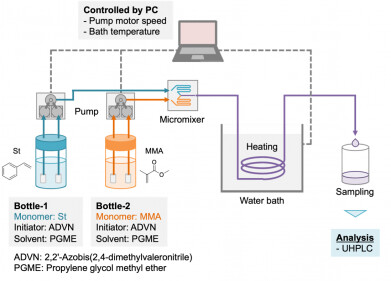-
 Researchers at the Linac Coherent Light Source, SLAC National Accelerator Lab used high intensity laser optical lasers pulse and X-ray pulses to stdy gold at the atomic level (Credit: SLAC)
Researchers at the Linac Coherent Light Source, SLAC National Accelerator Lab used high intensity laser optical lasers pulse and X-ray pulses to stdy gold at the atomic level (Credit: SLAC)
Research News
Laser excited gold elicits physics discovery
Feb 21 2024
An international team of scientists led by Queen’s University Belfast (QUB) have uncovered some previously unknown properties of gold, having demonstrated that the metal reacts unexpectedly to extreme temperatures. Their series of ground-breaking experiments were conducted with the help of world-leading high-spec laser technology available at the Linac Coherent Light Source (LCLS), part of the SLAC National Accelerator Lab in California.
Dr Adrien Descamps and Dr Emma McBride, both from the School of Mathematics and Physics at Queen’s University Belfast, led the research team from the UK, US, Germany and France. Working at the Matter in Extreme Conditions experimental hutch at LCLS, the team targeted thin gold films with optical laser pulses at the Matter in Extreme Conditions experimental hutch, then used super-fast X-ray pulses from LCLS to take atomic-level snapshots of how the material responded. Contrary to all expectations, the metal stopped melting and actually became harder and stronger past a certain heat threshold. Ever-increasing amounts of energy (heat) were then required to bring the gold to melting point.
While other materials such as silicon quickly fall apart when subject to intense laser pulses, the opposite response of gold becoming tougher and more resilient, indicates that the way in which gold atoms vibrate together – their phonon behaviour - changes. While this result had been predicted in theoretical simulations, it was never unambiguously observed before femtosecond technology came into existence
"Our findings challenge previous understandings by showing that, under certain conditions, metals like gold can become stronger rather than melting when subjected to intense laser pulses,” said Adrien Descamps, who led the research while he was a graduate student at Stanford and SLAC. “This contrasts with semiconductors, which become unstable and melt.”
While the discovery is in the realm of fundamental physics, it will have wide-ranging implications for technology and industry. In manufacturing in the aerospace and automotive industries, for example, laser technology is widely used to heat and machine hard metals for small, highly intricate and complex parts.
Now physicists are wondering what other metals – ‘noble’, precious or otherwise – may react in similar ways. There are theoretical predictions that copper, platinum and aluminium will behave like gold when ‘excited’, but that other materials such as tantalum – used to make ‘superalloys’ for aeroplane engines; and tungsten – an important material in the construction of fusion reactors, which could become an important source of clean energy in the future, will respond differently. Experiments on any element other than gold have yet to be conducted – this was a world-first.
Adrien Descamps explained the significance of this finding: “Our study is like a bridge between theoretical physics and the real world. And while the simulations of the past may have posited that this effect might be possible, our experiment has provided hundreds of data points, giving an enormous amount of detail and evidence which was previously unavailable.
“You can only get this kind of detail at the atomic level – we were probing the timescale between before applying the laser and the material blowing up – which is a tiny fraction of a split-second. You can only really study that at pico-second scale – it happens too fast to see with the naked eye or in ‘real time’.”
Emma McBride, a UKRI Future Leaders Fellow at Queen’s University, added: “It was such a privilege to use these highly specialised and expensive X-Ray machines and we are amazingly grateful for that opportunity. We wouldn’t have been able to carry out this experiment more than ten years ago – this kind of sophisticated machinery simply didn’t exist and we had no way of knowing how materials would respond to lasers at such intensity.
“By proving that phonon hardening is indeed real and can be evidenced, it will increase our understanding of how energy flows and how materials respond. This will be invaluable for the future of applied science and technology.”
The researchers carried out their experiments using the highest-resolution X-ray machines available in the world. Only five research facilities exist globally with this kind of equipment and top researchers must compete for highly prized and restricted timeslots.
The research is published in Science Advances
More information online
SLAC More Information online
Digital Edition
Lab Asia 31.6 Dec 2024
December 2024
Chromatography Articles - Sustainable chromatography: Embracing software for greener methods Mass Spectrometry & Spectroscopy Articles - Solving industry challenges for phosphorus containi...
View all digital editions
Events
Jan 22 2025 Tokyo, Japan
Jan 22 2025 Birmingham, UK
Jan 25 2025 San Diego, CA, USA
Jan 27 2025 Dubai, UAE
Jan 29 2025 Tokyo, Japan


















